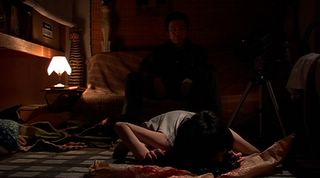Marebito
Japanese director Takashi Shimizu made Marebito in a little over a week, during a break between filming his horror film Ju-On and its American remake, The Grudge. Unsurprisingly, it's a lot more interesting than either of those movies. This peculiar slice of meta-horror is like an alternate-reality remake of Little Shop of Horrors, written by H.P. Lovecraft and directed by David Cronenberg.
I can't say the movie is entirely successful. Although occasionally creepy, it's never all that scary, and it's a lot better than building up tension than it is at paying off any of the various terrifying revelations it sets up. Still, for a movie shot on the fly, with digital cameras, in a week between making other, larger films, Marebito works well enough. Any movie that's this imaginative, unsettling and interesting is worthwhile, even if it's overwhelmed by its own style and it stumbles in the final half-hour.
Japanese actor-director Shinya Tsukamoto (maker of Tetsuo: The Iron Man, and star of Miike's famed Ichi the Killer) stars as a Tokyo cameraman slowly losing his grip on reality. Yes, this is another one of those movies where the supernatural events may all be in the head of an unreliable narrator. This whole "twist" is kind of being played out, particularly in Asian horror films, and it's only one of the unoriginal tropes that forms the basis of Shimizu's story. Somehow, he's able to fuse a lot of rather tired concepts into a story that feels somewhat fresh, but he's not wholly successful.
The cameraman, Masuoka, is gathering footage in a subway when he happens upon a man committing suicide. He captures the man gouging out his own eye with a knife on film, ad watches the tape over and over again. The look of horror on the suicidal man's face becomes an obsession. A cold, unfeeling, emotionless individual in his own right, Masuoka wants to experience the object terror that he sees in this man's face.
The quest eventually drives Masuoka underground, to the hidden, mysterious wasteland lying beneath the surface of Tokyo. He finds, among other things, a feral girl chained up in a craggy environment called "The Mountains of Madness" (the film's lone overt reference to the horror stories of Lovecraft), and of course he brings her back to his apartment.
Masuoka ritualistically films everything on a digital camera, and Shimizu continually cuts from his film to this grainy, dimly-lit footage. There are a number of scenes cleverly cutting between the two types of film, and the technique is occasionally successful at generating scares, but it's way overused during the course of the film. By the end, Shimizu's constant cutting back and forth has become annoying, diluting the tension right in the midst of a theoretically-scary sequence.
I mean, I think I get what he was going for. Masuoka is incapable of experiencing the world directly, preferring to view people and places through a camera. His quest for "terror" indicates his strong desire to relate, in an immediate sense, to what's going on around him, without the filter of recording equipment. But this concept is expressed early on in the film - continuing to jerk the viewer back and forth between two types of film becomes a pointless exercize in style after a while.
I'm also not sure how this Cronenberg-ian, technological-paranoia thriller links up to the fairly-traditional horror story with the primal girl from Underground. The girl (Tomomi Miyashita), known to Masuoka as F, consumes only fresh blood, leading to several scenes that are, unfortunately for Shimizu's purpose, highly reminiscent of the hijinks from Little Shop of Horrors.
Masuoka discovers her forbidden cravings after he cuts his finger, and she begins to suck it dry of precious bodily fluids. (I think Shimizu meant for this scene to resemble oral sex, but all I could think about was little Audrey II). Later, Masuoka will have no choice but to prepare a freshly-murdered corpse for consumption in his apartment. (No, it's not a dentist).
Campy allusions aside, this stuff is all pretty silly, particularly when the albino sewer monsters are introduced. By the time Shimizu returns to his Grudge bag of tricks, resorting to creepy girls with bangs covering their eyes and ghosts appearing in elevators, I started to tune out. I much preferred the psychological horror stuff about the cameraman losing his shit, mainly because of Tsukamoto's eerily distant performance.
Still, you have to give the guy credit. This movie has a lot more going on than, say, that American Grudge remake. I mean, it had a few decent sequences, but the thing didn't really make sense at all. Also, as a general rule, you don't want to kill off Bill Pullman in the first scene, if your only other star is Sarah Michelle Gellar. Something to think about...

2 comments:
"Asian cinema" is the new "independent film"- sooooo over.
Tell me about it. That's exactly why I only watch snuff films.
Oh, sure, people may give me a hard time now. But in 10 years, when Tarantino and Rodriguez are teaming up for one, you'll know you heard it here first.
Post a Comment